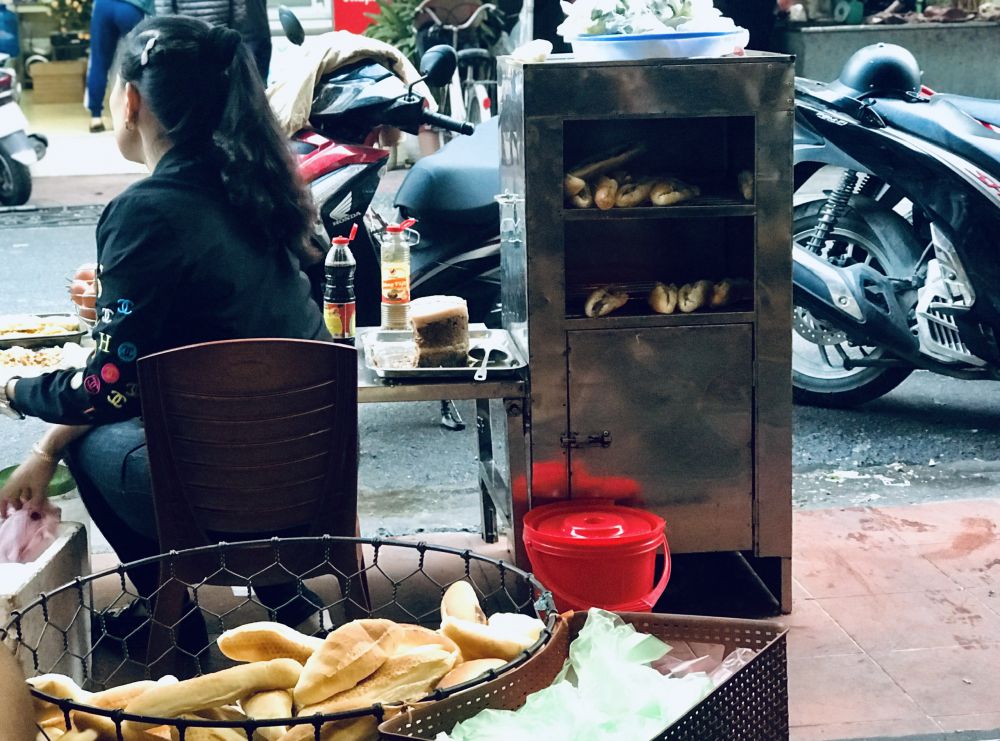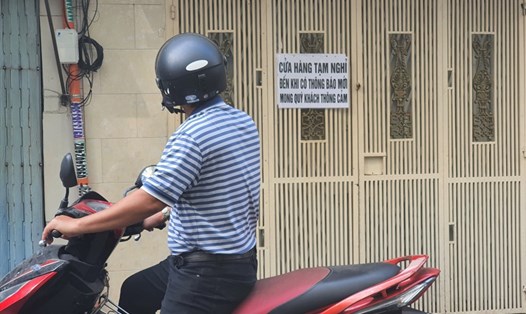THE STORY OF THE BREAD
That afternoon, the smell of charcoal-baked bread, hot pate, lard, chili sauce, coriander... in Mrs. Lau's bread was just waiting for my footsteps to come back and make the atmosphere bustling and joyful again, just like 30 years ago.
Under the influence of the French colonial period, almost all cities are familiar with the bread. Who doesn’t feel warm when hearing the “bustling childhood” cry flying on the street: “Hot and crispy bread. Who wants hot and crispy bread?” The sound “dei” is prolonged with the letter i, very enticing, enticing and stimulating.
Then came other cries, from other times: “Who wants hot and crispy Polish bread?” or “Saigon bread, thick and fragrant with butter, 1,000 VND a loaf.” The cries of bread cries flew all over the city, from the streets lit by high-pressure lamps to the dark alleys dimly lit by oil lamps.
Not only in Nam Dinh, Hanoi or Saigon, anywhere in this soft S-shaped land, bread is a familiar dish, filled with the joyful emotions and crispy laughter of a delicious piece, of a delicious but extremely simple meal.
The bread is so close to people, to the streets, to everyday life that it also contains the soul of the Vietnamese people, knowing how to find happiness even if it is just a loaf of bread that is not hot, each bite exudes an attractive aroma.
Bread is simply a bread made from wheat flour and baked. Wheat flour is not a Vietnamese food, but it followed the French legionnaires to Vietnam in the late 19th century, and turned Vietnam into a colony. When bread appeared, it was not called bread but “western bread”.
However, the Vietnamese have “Vietnamized” Western bread into banh mi by reducing the size, turning the large Western baguettes, up to half a meter long, which had to be sliced before eating, into small breads, more suitable for the Vietnamese to hold and eat. That “Vietnamization” process has helped banh mi contain the fragrant and tolerant hearts of the Vietnamese people.
That heart can contain the whole world from pate, cold cuts, ham, fried sausage, pork roll, shredded chicken, grilled beef, butter, cheese, shredded pork floss, cucumber, pickled vegetables, chili sauce, herbs, coriander... to create a delicious piece full of starch, vegetables, fiber, and nutrients.
The inside of the bread is small but contains everything we like, but the bread is not overflowing or ostentatious, but hides all the deliciousness inside, gently closing its mouth to then offer all the deliciousness to people in each crispy and enjoyable bite.
The process of adapting a Western bread, creating a Vietnamese dish and then bringing bread to the world to conquer Western tastes has created a Vietnamese delicacy that meets the fast-paced lifestyle, but still provides adequate nutrition and the joy of enjoying a delicious meal.
No wonder, the world's leading culinary and travel magazines have respectfully chosen Vietnamese bread as the best street food in the world. No wonder, foreigners do not call Vietnamese bread "bread" but have to call it "banh mi" with admiration.

NAM DINH BREAD
We cannot remember how many loaves of bread we have eaten or where we have eaten them. However, we probably cannot forget the loaves of bread that we remember from time to time, and crave from time to time. Because it has been identified with the happy feeling of “a delicious bite is remembered for a long time, a painful blow is remembered for a lifetime”.
In that memory, I still see my bread floating in the nostalgic waves. They were the breads made at the food store near My Tho market, heavy with flour, slightly gray inside due to being made with poor quality flour, but still created long lines of people waiting to buy them.
They are fragrant Polish loaves, dense and spongy, soft and fragrant “very Western” made from premium white flour and produced on a production line aided by the Polish Government in the 1970s, which was rarely provided to Nam Dinh and Hanoi. And also loaves from private bakeries that are huge because of the amount of baking powder.
The aroma of freshly baked bread led me to Mrs. Lau’s pate sandwich shop. This place is like every other pate sandwich shop in the city: no name, no sign, no shop, and only opens during a certain time of the day.
Mrs. Lau's bread is actually just a sidewalk bakery, located in front of the entrance and stairs of a building on Ly Thuong Kiet Street. This street is originally an open-air market, like an extension of My Tho market. During the day, it is open and deserted at night, so Mrs. Lau set up tables to sell bread.
A low rectangular table made of mixed wood, with no smell of paint, the edges of the table were covered with knife marks and burn marks, and the table top was stained with grease. At the head of the table was a round metal stove, usually cut from an old barrel, covered with a charcoal stove that was always glowing red hot.
The oven wall has many holes to place small iron bars to form a rack for the bread. Usually, the bread is kept warm in a large basket stuffed with rags and placed next to the oven. On the table is an enameled iron tray or aluminum tray containing a block of pate about 20cm in diameter, light pink to brown, with a layer of white fat on top.
This is a characteristic of Nam Dinh pate and specifically of Mrs. Lau. Pate is made from finely ground pork liver, lean meat and pork skin in a certain ratio to create adhesion for the pate. The process of grinding the ingredients is very important because it determines the quality of the finished pate: soft, smooth, melts in the mouth or hard, dry and crumbly; fragrant, rich, fatty or smelly...
The mixture is then poured into a steamer - usually a pot, so it has a diameter of 20cm. The mold is lined with thick, tough, fatty layers of pork fat. When steamed, the heat melts the fat and permeates the pate, creating a soft, succulent look. After steaming, wait for it to cool before pouring the pate onto a tray, thus creating the characteristic texture of pate on the bottom and pork fat on the top.
The pate tray is placed in front of a rectangular wooden cutting board - where the bread is kneaded - along with a bowl of lard, a jar of chili sauce, a basket of chopped herbs and coriander, and a salt and pepper shaker.
The bread in the basket was already hot, but it was still placed in the oven to make it crispy. When a guest came, the oven door was opened to take out the bread. First, use a knife to cut lengthwise on the side of the bread. As soon as the knife was released, immediately use two fingers to spread the cut open, then use a spoon to pour the fat into the bread and sprinkle a layer of salt and pepper.
Then use a knife to cut a piece of pate with enough fat into thin slices or lengthwise bars and spread it on the inside of the cake. Once the amount of pate is enough, drizzle a spoonful of fat on top, along with salt and pepper, herbs, chili sauce, and a layer of whole coriander leaves on top. Place the cake on a piece of paper to cool it down and prevent the grease from spreading, and you're done.
Receive the bread, depending on your taste, you can add salt, pepper and chili sauce and eat it while it is still hot and crispy. Each bite creates a "crackling" sound and thousands of pieces of bread fly out. The light, spongy and crispy bread has absorbed the fatty taste of the lard, creating a base for the fatty pate, fragrant with liver, smooth and soft.
However, the most enjoyable feeling is when you bite into a piece of nape fat, because immediately, the space between your teeth is flooded with a warm, fatty and fragrant liquid characteristic of animal lipids. To balance the fat, there is the spicy taste of homemade chili sauce and the cool taste of herbs and coriander.
The pleasure of eating that pate sandwich increased with the cold winds blowing along the street. The street ran in a checkerboard pattern, with few trees, so the cold wind blew freely. Only the heat from the bakery, from the pate sandwich in hand, and the slight yellow of the light bulb could dispel that cold. The sound of people exclaiming over the spicy chili sauce kept ringing out as if teasing the monsoon.
Now, Mrs. Lau’s bread is in the house on the street, Mrs. Lau has gone somewhere and left the bakery to her daughter. The bread also has many other fillings besides pate, and also has pickles instead of just herbs and coriander. But it is still the same old Mrs. Lau’s bread with smooth pate and fatty nape.
So every now and then, I come back to eat a piece of Mrs. Lau's bread!











